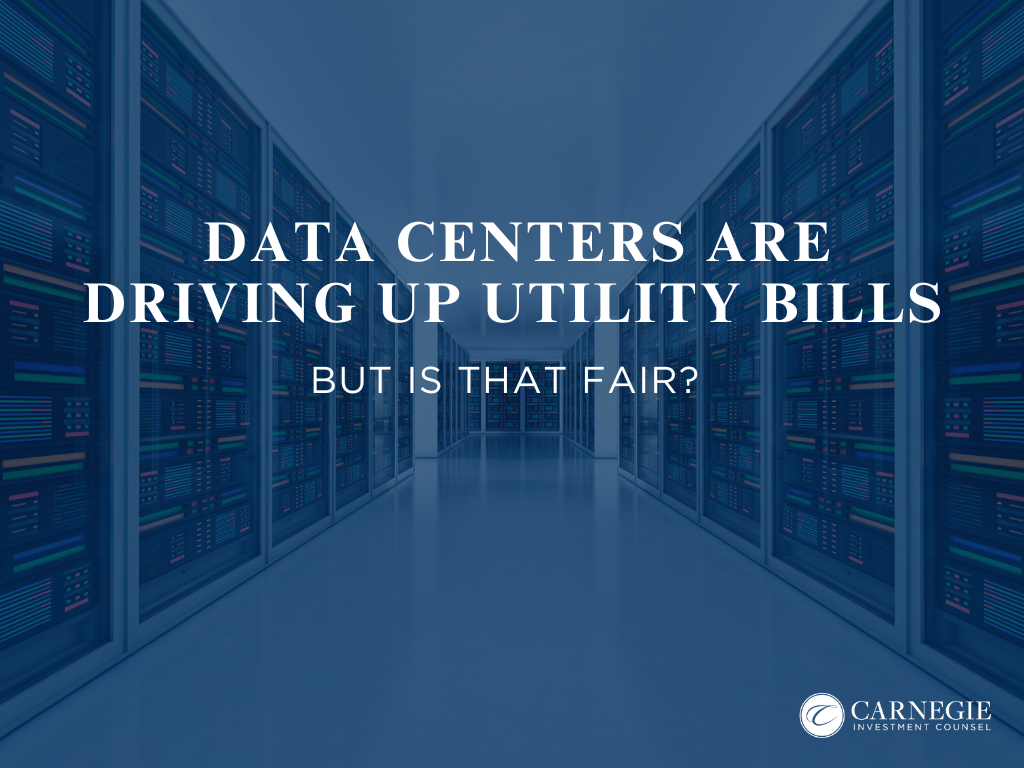Electricity prices are climbing as tech giants like Amazon, Google, and Microsoft build massive data centers to train and run their Artificial Intelligence (AI) models. These facilities are the digital backbone of today’s AI revolution, but they’re also consuming staggering amounts of power.

The New Power Hogs: Data Centers
AI data centers are enormous. Microsoft’s Mount Pleasant, Wisconsin facility spans 1.2 million square feet, roughly the size of 20 football fields. Inside facilities like this, thousands of servers hum constantly, delivering the computing power and storage required to train and operate advanced AI models like OpenAI’s ChatGPT and Alphabet’s Gemini.
All this processing means the centers need massive amounts of electricity to keep servers running and cool around the clock. And just like any other market, when demand goes up, prices follow.
When Demand Surges, Everyone Pays
As data centers demand more electricity, utilities must generate and distribute more power, often through infrastructure that needed upgrading in the first place. Most of our utility infrastructure was built in the 1960s and 1970s. When a utility projects the need for more power, they build out their infrastructure, and regulators allow them to earn a return on investment (ROI). Utilities earn this ROI by charging all customers more for delivering their electricity.
This is why data center demand is driving higher utility bills for everyone, even if your own energy use hasn’t changed. And the pressure is only expected to grow. According to Bloomberg, power demand from data centers is projected to double by 2035, accounting for nearly 9% of total U.S. electricity consumption.
Why It Feels Unfair
For most households, this price hike feels especially frustrating and for good reasons.
First, electricity demand is relatively inelastic. Unlike switching from orange juice to apple juice when prices rise, consumers can’t easily stop using electricity. When rates increase, you simply pay more.
Second, data centers, not consumers, are causing the surge in demand. While AI promises transformative benefits, most consumers have yet to feel those benefits in their daily lives. Instead, the most tangible effect may be higher electric bills. It’s one thing when a new manufacturing plant opens in town, raising utility rates but also creating thousands of jobs. Data centers, by contrast, create jobs during construction but require far fewer long-term employees once operational.
Making Tech Companies Pay Their Fair Share
So, what’s being done? Utilities and lawmakers are starting to push tech companies to cover more of the costs they create.
In Oregon, the Power Act, passed in June, allows utilities to recover expenses tied to large-scale electricity users like data centers. In Wisconsin, where Microsoft’s massive campus is being constructed, utilities have proposed a special tariff requiring “very large customers” to pay for the additional infrastructure and power capacity they consume.
Still, despite these measures, electric rates are increasing nationwide, especially in areas near new or expanding data centers.
The Balancing Act Ahead
There’s unlikely to be a perfect solution. Data centers will continue to fuel rising electricity demand, and consumers will inevitably share some of the cost.
The goal, however, should be fairness and transparency to ensure that tech companies contribute proportionately to the infrastructure on which they depend. Higher-than-anticipated costs to operate data centers could have some impact on spending plans. There has already been some skepticism about massive AI spending, and that would only increase with higher costs. However, as AI technology improves, more consumers will likely benefit and perhaps feel that the higher utility bills are justified.
AI may be reshaping the future, but its growing energy appetite reminds us of the fact that innovation always has a price. And right now, we’re paying that price.
For informational and educational purposes only.
Carnegie Investment Counsel (“Carnegie”) is a registered investment adviser under the Investment Advisers Act of 1940. Registration as an investment adviser does not imply a certain level of skill or training. For a more detailed discussion about Carnegie’s investment advisory services and fees, please view our Form ADV and Form CRS by visiting: https://adviserinfo.sec.gov/firm/summary/150488


